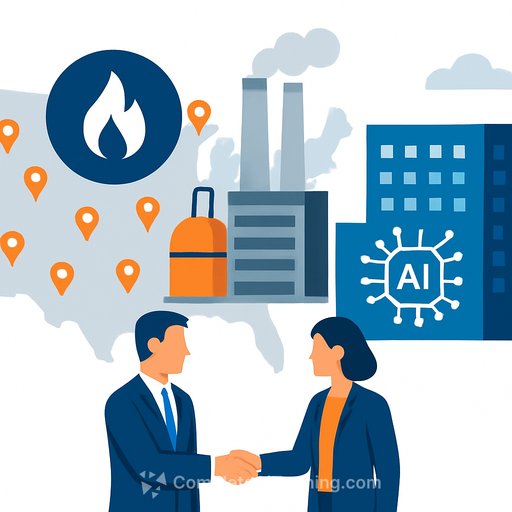1 GW AI Data Center Partnership Reshapes Site and Build Strategy Across 10 States
Overwatch Capital and Idemitsu Kosan have formed a 1 gigawatt partnership to develop energy-resilient, high-density AI data centers across Ohio, Texas, Illinois, Utah, Colorado, Arizona, Georgia, Nevada, South Carolina, and Pennsylvania. Idemitsu will launch nationwide natural gas supply operations in the U.S. and feed on-site generation for Overwatch's sites, supporting both grid-connected and private-grid models.
For real estate and construction teams, this is a clear signal: AI campuses are moving where firm energy and rapid delivery are viable. The model de-risks interconnection delays, leans on on-site natural-gas generation paired with battery storage, and enables parallel builds for hyperscalers and GPU-cloud providers.
Why this matters for development timelines
Interconnection queues continue to slow grid-only projects, pushing developers to hybrid or private microgrids to hold schedule. On-site natural-gas generation and BESS can keep projects moving while utility upgrades catch up, or operate as the primary source when grid access is constrained.
For owners and GCs, this shifts critical path activities from "wait on substation" to "permit, procure, and commission on-site generation." It also changes early utility coordination-more gas engineering, more emissions work, tighter controls integration.
Where the demand is heading
The partnership targets ten states with strong fiber, logistics, and energy access: OH, TX, IL, UT, CO, AZ, GA, NV, SC, and PA. Overwatch expects initial projects in 2026 with Resilience Dallas-Fort Worth and Resilience Columbus, bringing high-density GPU clusters, liquid cooling, and ultra-high rack power into markets with pro-development policies and talent pools.
Specs and systems to plan for on AI campuses
- High-density compute: Facilities support next-gen GPU clusters, liquid cooling, and ultra-high rack power densities. Plan for floor loading, hot/cold containment, and liquid distribution architecture early.
- On-site generation: Natural-gas systems sized for primary or hybrid operations. Account for gas interconnects, pressure regulation, enclosures, sound attenuation, and selective catalytic reduction for emissions control.
- Battery energy storage (BESS): Layout, clearances, and fire protection per code. Ensure egress, ventilation, detection, and coordination with AHJs.
- Cooling strategy: Liquid and potential immersion options. Mechanical rooms, fluid loops, dry coolers or towers, water sourcing and discharge, and heat-reuse opportunities where practical.
- Resiliency layers: Microgrid controls, islanding, black start, and multi-source backup (including diesel for contingencies). Cable routing and switching philosophies should match mission-critical uptime targets.
- Security and data integrity: Controlled perimeters, segregated halls, and dedicated feeds for enterprise- and cloud-scale tenants.
Permitting and utility coordination checklist
- Natural gas: Capacity studies, tap agreements, pressure/flow specs, potential compression, easements, and metering locations.
- Air permits: NOx/CO limits, modeling, stack heights, SCR/oxidation requirements, and construction permit timelines.
- BESS compliance: Fire code submittals, technology selection, and emergency response plans.
- Water and discharge: Cooling water supply, blowdown/disposal, and stormwater management for large impervious areas.
- Electrical integration: Private-grid design, protection schemes, and Island/Sync logic; parallel path for future utility interconnects.
- Noise and community: Acoustic modeling, setbacks, screening, and traffic plans during peak construction and equipment deliveries.
- Site readiness: Geotech, floodplain, seismic, crane paths, and laydown areas sized for large gensets, switchgear, transformers, and modular data hall components.
Procurement and schedule risks to control
- Long-lead equipment: Switchgear, transformers, gas gensets/turbines, BESS, heat exchangers, and liquid cooling components.
- Modularization: Standardized blocks for power, cooling, and data halls to compress schedules and run parallel trades.
- Controls integration: Early alignment on microgrid, EMS, and security systems to avoid late-stage commissioning conflicts.
- Fuel logistics: Gas reliability plans plus diesel backup supply contracts and on-site storage compliance.
What Overwatch and Idemitsu bring to a project
- Firm natural gas supply for on-site generation across ten markets, supporting high-density AI compute.
- Dual private-grid and grid-supplied energy models to reduce interconnection risk and keep delivery dates intact.
- Overwatch's SIDE Platform: Integrated on-site generation, battery storage, advanced cooling, and proprietary energy management for efficiency and uptime.
- Expanded energy services via Idemitsu: immersion cooling exploration, diesel backup supply, potential battery deployments, and fuel cell options.
- Security-first environments built for enterprise and cloud operators with mission-critical resiliency and sustainability features.
Financing signal
Marathon Capital advised on the partnership and will lead corporate and project-level financing as Overwatch finalizes tenants. For developers and institutional owners, this indicates bankable structures tied to energy-backed data platforms, which can support precommitments and faster capital cycles.
For municipalities and EDCs
- Zoning that accommodates on-site generation, fuel storage, and BESS-plus streamlined permitting for mission-critical facilities.
- Right-of-way support for gas, water, and fiber; clear processes for air permits and utility coordination.
- Workforce pipelines for electrical, mechanical, controls, and specialized cooling trades.
- Incentives aligned to energy resilience, heat reuse, and local supplier participation.
Action steps for owners, developers, and GCs
- Shortlist sites near major gas lines, fiber routes, and existing or planned substations; validate logistics for heavy transport.
- Run a dual-track utility plan: private microgrid design with a parallel grid interconnection path.
- Pre-negotiate fuel, emissions equipment, and long-lead MEP packages; lock commissioning partners early.
- Establish a governance model for tenant segregation, security, and energy allocation across multi-tenant campuses.
Context and resources
For background on interconnection queue pressures, review current research from the U.S. national lab community: LBNL Interconnection Queue Tracker. For gas market fundamentals that influence siting and capacity, see the U.S. EIA natural gas overview.
About the companies
Overwatch Capital develops sustainable digital infrastructure through its SIDE Platform and Resilience Series data centers, integrating energy and compute for efficiency and uptime. Idemitsu Kosan, through Idemitsu Americas Holdings, is expanding U.S. energy operations with nationwide natural gas supply and additional services for data centers, including immersion cooling, diesel backup, and battery storage. Marathon Capital, an independent investment bank focused on the clean economy, advised the formation and will lead financing efforts.
If your team is building AI skills to evaluate and deliver these projects, explore practical training by job role: AI courses by job.
Your membership also unlocks:






